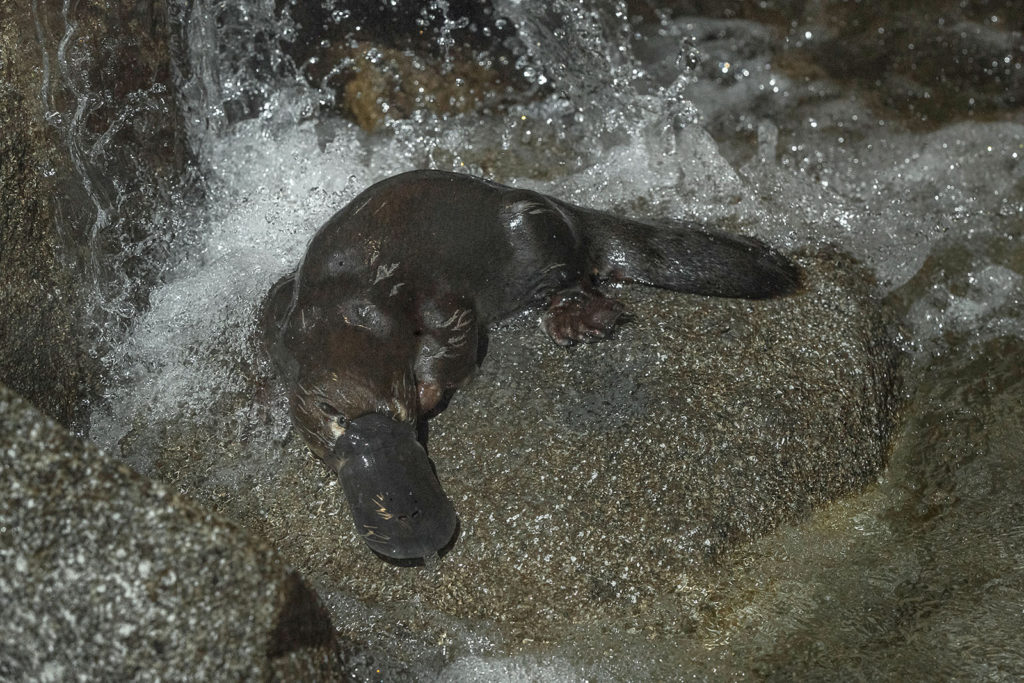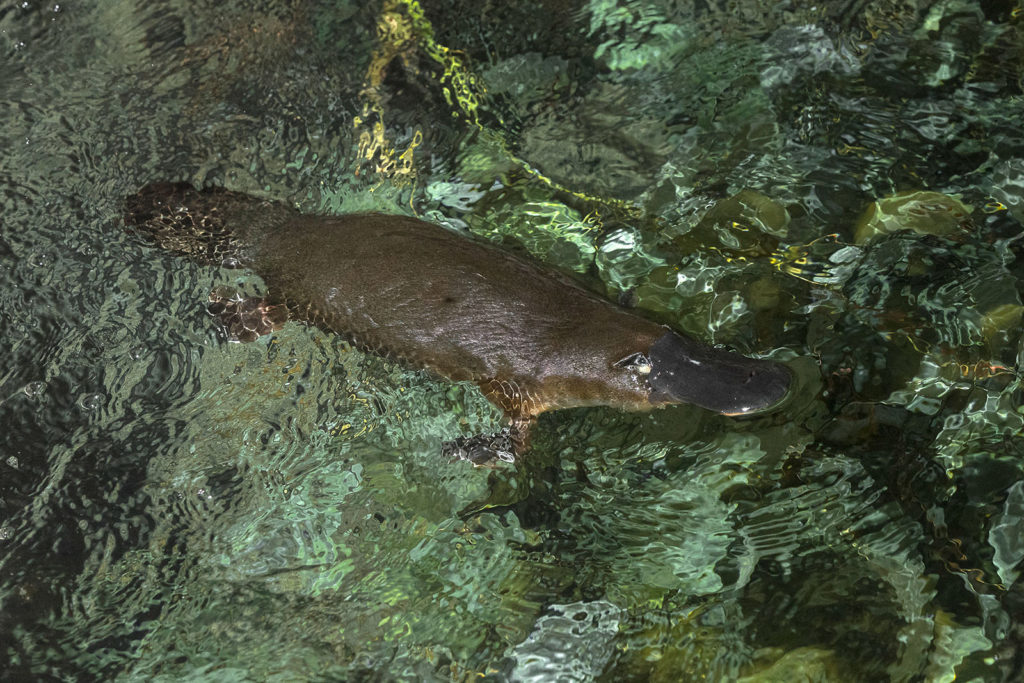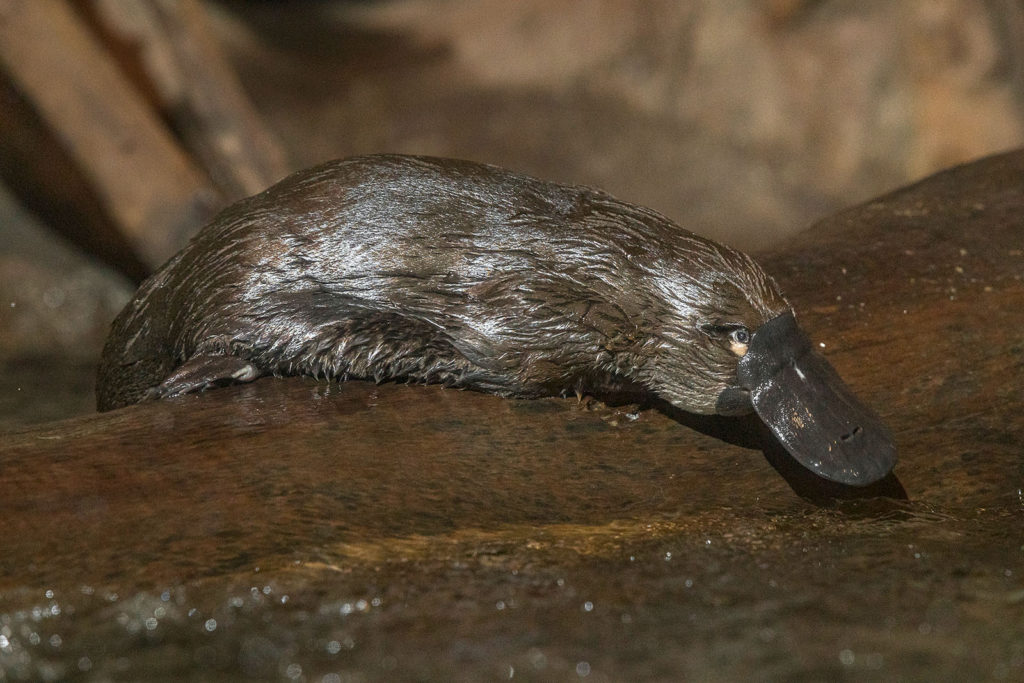
Animals Will Serve as Ambassadors for Their Species Outside of Their Native Country
The San Diego Zoo Safari Park announced the arrival of two platypuses from Australia and the official opening of the Nelson M. Millsberg Platypus Habitat at the Safari Park’s Walkabout Australia earlier today (Nov. 22, 2019). The two platypuses were flown to San Diego from their home at Australia’s Taronga Zoo Sydney in late October, to serve as ambassadors for the species outside of their native Australia. The San Diego Zoo Safari Park is currently the only zoo outside of Australia to house platypuses—and this is the first time in more than 50 years that platypuses have been cared for outside of Australia.
The opening of the Safari Park’s new platypus habitat included a ceremony, dance and special acknowledgement from Elder Rory O’Connor, representing the Yugambeh (pronounced you-gum-bear) Language Peoples of the Gold Coast of Australia; and comments from Chelsey Martin, consul general, from the Australian Consulate in Los Angeles. Representatives from the San Pasqual Band of the Kumeyaay (Comm-yai) Elders also attended.
“All of us at San Diego Zoo Global are extremely honored and excited to welcome the platypus to the San Diego Zoo Safari Park,” said Paul A. Baribault, president/CEO, San Diego Zoo Global. “Having platypuses at the San Diego Zoo Safari Park allows us to broaden the work of Australian zoos to raise awareness for the unique species under their care. Millions of people will see these two animals here, will marvel at the amazing diversity of wildlife and, through this feeling of respect and awe, will recommit to taking conservation action that will save species around the world. Caring for these two platypuses, and sharing them with our audiences, is a great responsibility—a responsibility San Diego Zoo Global takes on with every species we pledge to work with,” Baribault added.

The two platypuses—an 8-year-old male named Birrarung and a 15-year-old female named Eve—were flown to the U.S. in specially designed platypus travel crates that included insulated panels, ventilation and cameras, as well as temperature and sound loggers. Many months of preparation and training went into ensuring the successful transfer of the platypuses. To appropriately care for the species, three San Diego Zoo Safari Park keepers and a veterinarian traveled to Australia to train in platypus husbandry and health care. A Taronga Zoo platypus keeper accompanied the platypuses on their journey and stayed in San Diego for two weeks to help the platypuses acclimate to their new home. In addition, representatives from Taronga Zoo consulted in all aspects of the habitat design.
The Safari Park’s world-class platypus habitat includes three pools, naturalistic river banks, extensive tunnels and nesting areas. The habitat was built more than a year ago, in anticipation of the platypuses’ arrival, through the generous gifts of more than 500 donors. Safari Park animal care specialists report the two platypuses have acclimated well to their new home. “They have wasted no time exploring every inch of their habitat, swimming all around their pools, playing in the waterfalls, and foraging and hunting for their crayfish,” said Lori Hieber, lead keeper, San Diego Zoo Safari Park. “Every behavior we have seen indicates they are very comfortable, and have settled in nicely.”

San Diego Zoo Global has a long history of working with colleagues in Australia and caring for Australian species, including koalas, Tasmanian devils, kangaroos, wallabies, wombats, echidnas, sugar gliders, cuscus, many bird species—including cassowaries—and many reptile species.
These platypuses serve as ambassadors for the species outside of their native Australia and communicate the importance of fresh water for both humans and wildlife. Freshwater resources and habitats are being affected by pollution and climate change. People are encouraged to be part of the solution and protect wildlife through water conservation measures and practices that help slow climate change.
To understand what is occurring with platypuses in Australia—and to better understand the conditions they live in, and those affecting other river species—San Diego Zoo Global has pledged an ongoing commitment of funds to field conservation of platypuses. San Diego Zoo Global, the University of Melbourne and the conservation group cesar have teamed up to begin a unique project designed to learn more about the elusive platypus and the threats to its survival. The project uses innovative technology, in which samples of water are tested for traces of environmental DNA (eDNA) to learn about the species present in freshwater ecosystems. This is the largest survey undertaken for platypuses and will allow researchers to comprehensively map their current distribution. The information will guide future steps for the protection of platypuses and the ecosystems they depend on throughout Victoria and New South Wales. The ongoing study is also important to help better understand and evaluate how human activity is affecting this species.

The platypus is a semiaquatic, egg-laying mammal found along the eastern coast of Australia, within the states of Queensland, New South Wales, Victoria and Tasmania. They live in freshwater streams, creeks and rivers.
Platypuses are unique in appearance, having a long snout resembling a duck’s bill, a beaver-like tail, webbed feet and dense fur. They are excellent swimmers, paddling with their front webbed feet and steering with their hind feet and tail. While swimming, folds of skin cover their eyes and ears to prevent water from entering, and their nostrils close with a watertight seal. Platypus can remain submerged for about 20 to 40 seconds at a time.
Platypuses are most active during dusk and nighttime hours, and they generally sleep during the day. To allow Safari Park guests the best possible viewing opportunity and also provide an optimum environment for the platypuses, the lighting cycle in their habitat has been reversed so it mimics nighttime during daylight hours and daytime during nighttime hours. Platypuses can be difficult to see, both in the wild and in a zoological setting, so being able to get a glimpse of these elusive, busy animals is a rare and special experience.
At the San Diego Zoo Safari Park, the platypuses receive a diet of live prey consisting primarily of crayfish or “yabbies,” as they are called in Australia, along with worms and other aquatic invertebrates.
The platypus is listed as Near Threatened on the International Union for Conservation of Nature (IUCN) Red List of Threatened Species, primarily due to habitat destruction, climate change, predation and direct human contact. Scientists do not know the number of platypuses in the wild, but estimates range from 10,000 to 100,000.
Guests can visit the new platypus habitat at Walkabout Australia during regular Safari Park hours. Walkabout Australia at the San Diego Zoo Safari Park offers a view into the Land Down Under, featuring Australia’s interesting and unique species.Walkabout Australia takes guests through four different types of Australian habitats: grassland, rain forest, wetlands and desert. Featured animals besides the platypus include Matschie’s tree kangaroos, western gray kangaroos, red-necked wallabies, and southern cassowaries.




